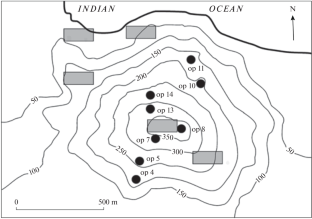Composition of Phenocrysts in Lamproites of Gaussberg Volcano, East Antarctica
IF 0.7
4区 地球科学
Q4 GEOCHEMISTRY & GEOPHYSICS
引用次数: 0
Abstract
Abstract—This paper presents numerous new data on the geochemical composition of olivine, clinopyroxene, and leucite phenocrysts, as well as spinel inclusions in olivine and quench glass from lamproites of Gaussberg volcano (East Antarctica). Most of the olivine phenocrysts in the Gaussberg lamproites are high Mg varieties (Fo89–91) with elevated Ni contents (up to 4900 ppm) and high Ni/Co ratios. According to data of about 320 clinopyroxene analyses, two groups of diopsidic phenocrysts have been established. Group I consists mainly of high-Mg varieties (Mg#>80), while group II clinopyroxenes are less magnesian (Mg# 52–80). The main difference between the clinopyroxenes of the two groups is the elevated contents of Al2O3, FeO and reduced TiO2, Cr2O3, and NiO in the compositions of group II compared to group I, as well as different contents of trace elements, which may reflect their crystallization from different types of primary melts. According to the study of ~550 grains of leucite phenocrysts in the Gaussberg lamproites, it was shown that they correspond to the ideal stoichiometry of leucite K[AlSi2O6] and are enriched in Na2O (0.05–0.35 wt %), but depleted in K2O (19.9–20.9 wt %) compared to leucites from lamproites of other provinces. The BaO content reaches 0.3 wt %, SrO –0.04 wt %. The iron content in most leucite phenocrysts varies within 0.7–1.2 wt % Fe2O3, but some grains have the low Fe2O3 contents (<0.5 wt %). In leucite microlites of the groundmass and rims of phenocrysts, the Fe2O3 content can reach 2.4 wt %, which may indicate more oxidized conditions at lava eruption. Based on the study of natural samples, existing experimental data and numerical models, the order and conditions of crystallization of the Gaussberg lamproites were obtained. Crystallization proceeded in the following order: chromian spinel → chromian spinel + olivine → olivine + leucite (± chromian spinel) → olivine + leucite + clinopyroxene (± chromian spinel). The near-liquidus assemblage represented by high-Mg olivine phenocrysts with inclusions of Cr-spinel was formed in the temperature range from 1180 to 1250°C. Further crystallization of the melt with the formation of an association of olivine+leucite+clinopyroxene phenocrysts could occur at pressures below 2 GPa and temperatures of 1070–1180°C, corresponding to the presence of water in the magmatic system. Estimates of the redox conditions of crystallization of lamproites obtained using different oxybarometers vary in a wide range from QFM-0.5 to QFM+2.3. The elevated Ni contents in liquidus olivines of Gaussberg indicate the high nickel contents in the source. It is shown that the formation of ultra-alkaline magmas in the Gaussberg volcano area is likely related to melting of the continental lithosphere, which was heterogeneous and included both the peridotite mantle and hydrous pyroxenite fragments.

东南极洲高斯堡火山煌斑岩中斑晶的组成
摘要:本文介绍了南极东部高斯堡火山煌斑岩中橄榄石、斜辉石和白晶石斑晶的地球化学组成,以及橄榄石和淬火玻璃中的尖晶石包裹体的新数据。高斯堡煌斑岩中的橄榄石斑晶多为高Mg品种(fo89 ~ 91),镍含量高(可达4900 ppm),镍钴比高。根据约320份斜辉石分析资料,建立了两组斜辉石斑晶。第一类以高镁品种为主(Mg#>80),第二类斜辉石质镁含量较少(Mg# 52 ~ 80)。两组斜斜辉石的主要区别在于,II组斜斜辉石的Al2O3、FeO含量高于I组斜斜辉石,而II组斜斜辉石的TiO2、Cr2O3、NiO含量低于I组斜斜辉石,其微量元素含量也不同,这可能反映了它们是由不同类型的原生熔体结晶而成。通过对高斯堡煌斑岩中~550粒白晶石斑晶的研究表明,与其他省份煌斑岩中的白晶石相比,它们符合白晶石K[AlSi2O6]的理想化学测量,富集Na2O (0.05 ~ 0.35 wt %),而贫K2O (19.9 ~ 20.9 wt %)。BaO含量为0.3 wt %, SrO含量为-0.04 wt %。大多数白晶石斑晶的铁含量在0.7 ~ 1.2 wt % Fe2O3之间,但有些晶粒的Fe2O3含量较低(<0.5 wt %)。在斑晶地块和斑晶边缘的白白石微岩中,Fe2O3含量可达2.4 wt %,表明岩浆喷发时氧化程度较高。通过对自然样品、现有实验数据和数值模型的研究,得到了高斯堡煌斑岩的结晶顺序和结晶条件。结晶顺序为:铬尖晶石→铬尖晶石+橄榄石→橄榄石+白晶石(±铬尖晶石)→橄榄石+白晶石+斜辉石(±铬尖晶石)。在1180 ~ 1250℃的温度范围内,形成了以高mg橄榄石斑晶和cr尖晶石包裹体为代表的近液相组合。在低于2 GPa的压力和1070-1180℃的温度下,熔体进一步结晶,形成橄榄石+白晶石+斜辉石斑晶组合,这与岩浆系统中存在水相对应。使用不同氧压计获得的煌斑岩结晶氧化还原条件的估计值在QFM-0.5到QFM+2.3的范围内变化很大。高斯堡液相橄榄石中镍含量升高,表明源岩中镍含量较高。结果表明,高斯堡火山地区超碱性岩浆的形成可能与大陆岩石圈的熔融作用有关,岩石圈具有非均质性,既包括橄榄岩地幔,也包括含水辉石岩碎片。
本文章由计算机程序翻译,如有差异,请以英文原文为准。
求助全文
约1分钟内获得全文
求助全文
来源期刊

Geochemistry International
地学-地球化学与地球物理
CiteScore
1.60
自引率
12.50%
发文量
89
审稿时长
1 months
期刊介绍:
Geochemistry International is a peer reviewed journal that publishes articles on cosmochemistry; geochemistry of magmatic, metamorphic, hydrothermal, and sedimentary processes; isotope geochemistry; organic geochemistry; applied geochemistry; and chemistry of the environment. Geochemistry International provides readers with a unique opportunity to refine their understanding of the geology of the vast territory of the Eurasian continent. The journal welcomes manuscripts from all countries in the English or Russian language.
 求助内容:
求助内容: 应助结果提醒方式:
应助结果提醒方式:


